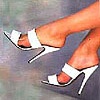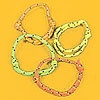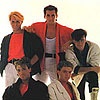I never really understood the desire to encase your feet, on the hottest days of the year, in shoes made from steamingly sticky plastic but 80’s jelly shoes were and still are, thanks to the resurgence of retro fashion, phenomenally popular. They come in an array of different styles, in pretty much every colour you can think of and are often highly glittery.
They’re called jelly shoes for exactly that reason: the material has a slight sheen to them which, in certain lights makes them appear a bit jelly-like, although they also can come in a more matt appearance.
Jelly shoes have been around for a lot longer than you might think. A quick scour of the website of Sun Jellies (the brand which has been making the original Méduse jelly shoes since 1946) reveals that Frenchman Monsieur Jean Dauphant came up with the idea of making shoes from plastic during a leather shortage in France after the Second World War. Once plastic became commonplace the shoe’s development expanded; school children in Australia were wearing them in the 1950s and 60s and shoe designers began playing around with the material. Their explosion in popularity in the 1980s in the U.S., however, can apparently be linked to two far-sighted American businessmen who, independently of each other brought the jelly shoe to the U.S.
In 1980 the New York Times reported on Bert Geller, a shoe manufacturer who saw some hotel workers in Greece wearing shoes made out of flexible plastic. He began to recreate them back home in the United States and managed to get big name stores Macy’s and Saks Fifth Avenue to sell them. They were bought by ladies of society, fulfilling Geller’s dream of making his jelly shoes the footwear to be seen in.
In 1981 Preston Haag Sr. discovered that a company called Grendene were making and selling jelly shoes in Brazil; realising their potential he then arranged to distribute them in the United States, the Caribbean and Canada. They were first marketed through Brazil’s stand at the 1982 World’s Fair in Knoxville, Tennessee (which also saw Coca-Cola introduce its new and sickly sweet Cherry Coke) under the new company name of Grendha.
Despite selling well on a local scale (priced at between $10 and $20 they were perfect for ladies wanting to fill their wardrobe with a selection of cheap summer shoes) Grendha’s versions of the jelly shoe didn’t become a nationwide success until Haag introduced them at a 1983 shoe exposition in Chicago. Spotted there by buyer Doris Johanson from Bloomingdale’s in New York, she ordered nearly two and a half thousand pairs in nine styles. They were featured in the department store’s catalogue and placed on the main floor of the shop, ensuring that all customers who passed through would see them.
Grendha produced new jelly shoe designs every six months and were given a big boost in the fashion stakes by enrolling four big name European designers to create these fresh styles – names including Thierry Muglar and Jean-Paul Gautier – ooh la la! They also branched out into distributing them in both Japan and the then West Germany and refused to sell-out to any chain or discount stores, preferring to keep them as desirable high-end fashion items.
Now, it might be slightly peculiar to you to read that these tacky, over-heating plastic shoes were once sold as an aspiring-to-luxury brand but it didn’t take long for them to become far more mainstream and for the price to tumble. Soon, every child in America was able to snap them up for as little as a dollar for a pair.
Jelly shoes became a huge trend for both children and adults alike; despite the perspiring feet and blisters combo that was the flip side to wearing them jelly shoes were produced in a multitude of colours and patterns.
A recent nostalgia throwback to 1980’s styles has seen them also gaining new fans in the twenty-first century; fashion brands have reinvented them so that adults can relive their childhoods and children can discover what it’s like to weld their skin to hot plastic.
Jelly shoe manufacturers are on to a winner: kids will always love them because they are bright, colourful and sparkly. Parents will always love their children wearing them as, because they are waterproof, wearing them means that they can play on the beach without risking bare feet treading on a sharp stone, shell or jellyfish.
And maybe the adults who wear them are nostalgically reminiscing for their lost, colourful, sunny summers as a child. Or maybe they just like sweaty feet. But if they do enjoy wearing them there is also the chance to coordinate their look with a jelly bag; made from the same material as the shoes they were also both massively popular in the 1980s and are back on the shelves again now.
Available in many colours, both glittery and not, they are ideal for shopping as they expand quite considerably to allow you to pack a great deal in. They are also fab for the beach (all the holes mean that any sand that finds its way in will generally find its way out before you get back to the car) so they are extremely all-round practical, even if you may look a little Barbie-fied when carrying one in bright pink.
So there we have it. Definitely not cool in the temperature sense of the word but many people consider them to be cool in the fashion world. I personally am not a fan, but they are cheap and times are hard so you never know. Anyhow, Jeff Bridges famously wore a see-through pair of jelly shoes in his role as The Dude in The Big Lebowski so if anybody spots me wearing them I’ll just say that I’m copying him.













Do You Remember Jelly Shoes?
Do You Remember Jelly Shoes?